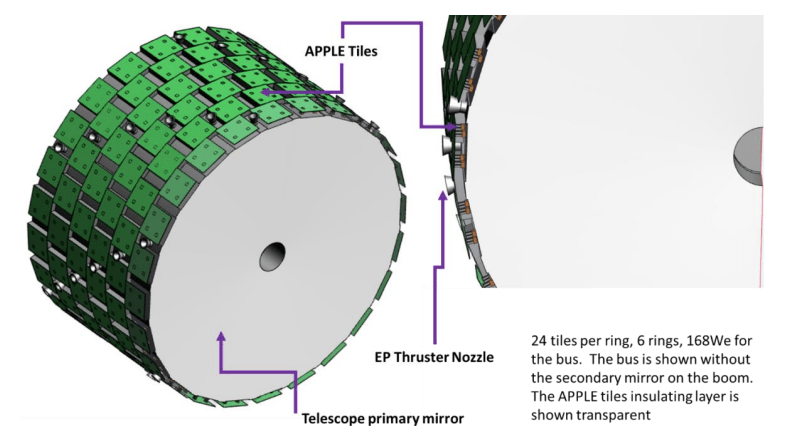Radioisotope thermoelectric generators (RTGs) are the power plants of the interplanetary spacecraft. Or at least they have been for going on 50 years now. But they have significant drawbacks, the primary one being that they’re heavy. Even modern-day RTG designs run into the hundreds of kilograms, making them useful for large-scale missions like Perseverance but prohibitively large for any small-scale mission that wants to get to the outer planets. Solar sails aren’t much better, with a combined solar sail and battery system, like the one on Juno, coming in at more than twice the weight of a similarly powered RTG. To solve this problem, a group of engineers from the Aerospace Corporation and the US Department of Energy’s Oak Ridge National Lab came up with a way to take the underlying idea of an RTG and shrink it dramatically to the point where it could not potentially be used for much smaller missions.
The concept, known as the Atomic Planar Power for Lightweight Exploration (APPLE) project, focuses on three main goals, according to a final report released by the authors:
- Generate Power
- Store that power
- Provide heat to other spacecraft components
The first goal is self-explanatory – it’s the goal of all previous RTGs, for that matter. The second goal deals with another weakness of RTGs – they start at peak power and only get weaker from there. So an RTG system must be designed with the operational lifetime of the mission in mind. If a mission is planned to last five years, the power output of the RTG must not decay past the point where it can still provide power to that system over that time frame.
APPLE uniquely solves that problem by providing energy generation and storage in one package that can either radiate heat away or direct it to other necessary components. That’s pretty standard practice in many industries, but the design of APPLE is what makes it truly unique.
Credit – JPLraw YouTube Channel
It is designed as a tile that outputs and stores a specific amount of power. The tile can either be single sided, and coat the outside of the spacecraft such that the waste heat generated can be radiated away, or it can be dual-sided, with the whole assembly isolated out on a strut from the spacecraft it is powering, like a solar sail.
What’s more impressive is that the tiles can be strung together – need a higher power output? Simply select the number of tiles right for your application, and you can be assured that is the amount of power and battery support you will receive when designing your spacecraft.
A long series of design decisions were considered during the NIAC project, and their results were detailed in a final report back to NASA. One primary consideration was what type of isotope to use. The authors settled on Plutonium-238, more commonly considered a component in nuclear bombs. However, this context showed a reasonable mix of heat generation while not requiring too much radiation shielding.
Radiation shielding was another major consideration, which tied into the place of the batteries in the tiles and their material composition. Dr. Joseph Nemanick and his co-authors ran numerous radiation simulations to try to answer both of those questions. They configured each tile such that the largest radiation source affecting the battery materials over a standard project lifetime (15-50 years in their consideration) would be from cosmic rays rather than from the highly fissile material contained in the tile itself.
Other positioning considerations, such as where to place the “hot shoe” and “cold shoe” in the thermoelectric system, also mattered. Luckily, models of such systems have improved exponentially over the past few decades, so engineers can have some idea of the best configuration before even making parts.
The APPLE team did make some parts, including battery components and a radiation test setup. However, it’s unclear from publicly available data whether the project has received further funding or its technical development status. APPLE is undeniably solving a problem ingeniously – it remains to be seen whether the technology will be adopted by the myriad of small interplanetary missions planned by the big space agencies.
Learn More:
Nemanick et al. – APPLE, ATOMIC PLANAR POWER FOR LIGHTWEIGHT EXPLORATION
UT – Astronomy Without A Telescope – Solar Or RTG?
UT – NASA Halts Work on its New Nuclear Generator for Deep Space Exploration
UT – Exploring the Outer Solar System Takes Power, Here’s a Way to Miniaturize Nuclear Batteries for Deep Space
Lead Image:
Artist’s conception of a deep space telescope mission encased in interlocked APPLE tiles.
Credit – Nemanick et al.

